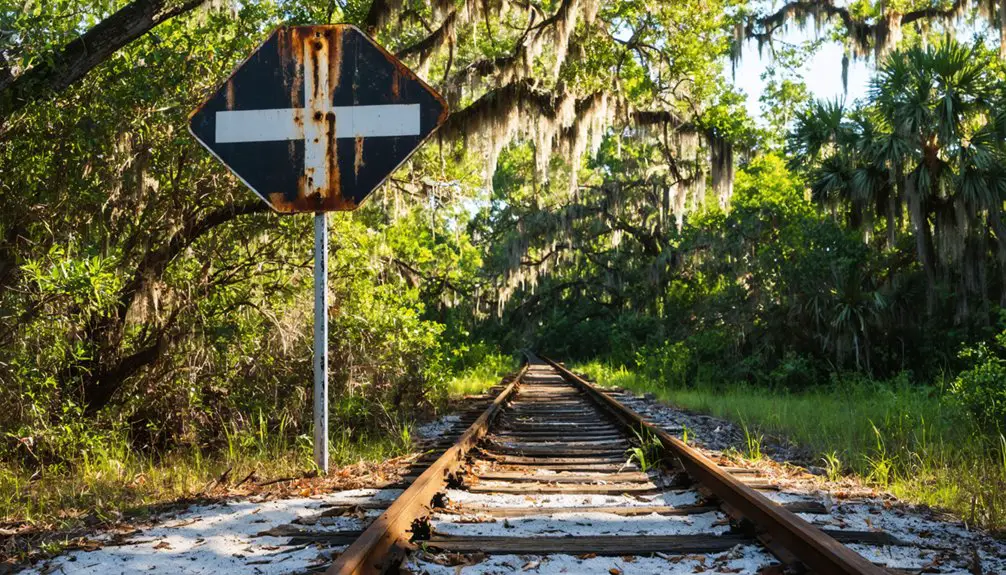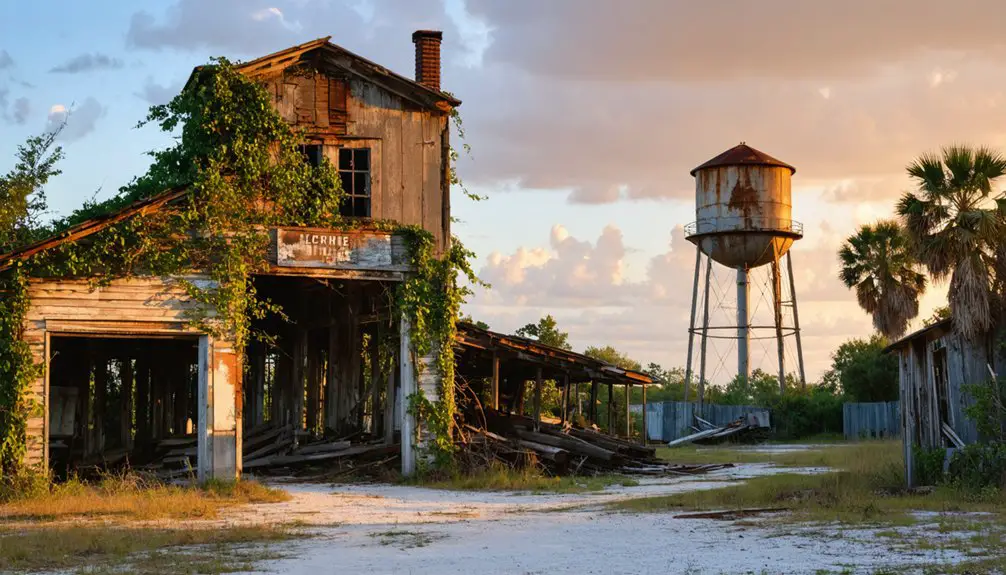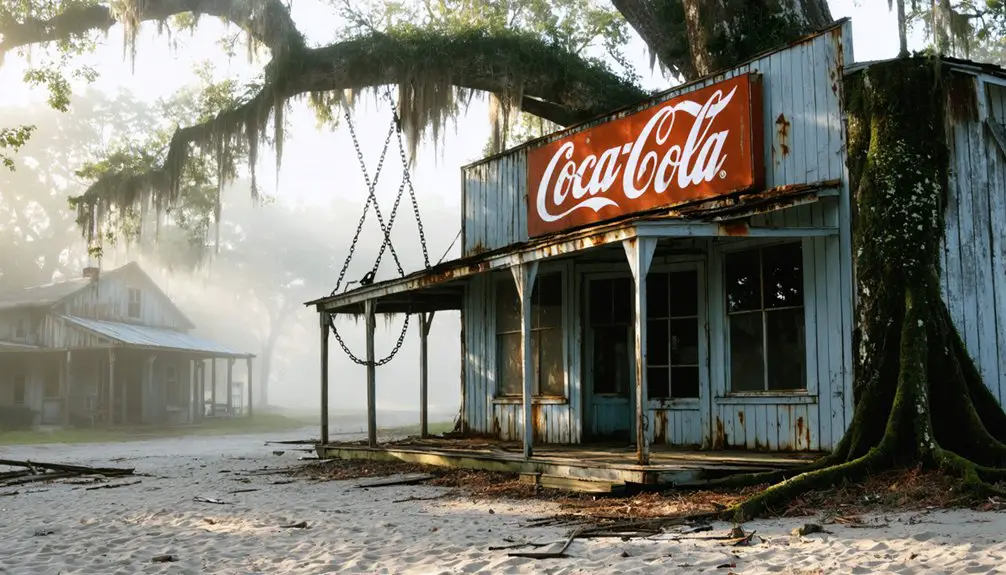You’ll find Crewsville’s ghost town origins in 1867, when Dempsey Dubois Crews Jr. and pioneer families established this Florida frontier trading post. The settlement thrived through its general store and trading relationships between settlers and Seminoles. But when the Florida Southern Railway bypassed the town in the early 1900s, followed by the post office’s closure in 1916, Crewsville’s fate was sealed. Today, only the Baptist church, cemetery, and scattered remnants hint at deeper stories of frontier life.
Key Takeaways
- Crewsville transformed from a thriving frontier settlement into a ghost town after being bypassed by the Florida Southern Railway.
- The closure of the town’s post office in 1916 marked a turning point, leading to significant population decline.
- Only the Crewsville Baptist Church, cemetery, and scattered historical landmarks remain as evidence of the former community.
- Founded in 1867 by pioneer families including the Crews, Collier, and Whidden clans, the town initially prospered as a trading hub.
- The town’s decline stemmed from loss of commerce and connectivity after missing crucial railway development in the early 1900s.
Early Pioneer Settlement and Founding Families
During the 1850s, Crewsville emerged as a pioneer settlement in Central Florida through the efforts of three primary founding families: the Crews, Collier, and Whidden clans.
The settlement’s establishment centered around Dempsey Dubois Crews, Jr., who joined forces with his uncle John Collier Sr. and father-in-law Enoch Collins Jr. to forge a new community about 14 miles southeast of Zolfo Springs in 1867. Town development became Crews’ primary focus until his tragic death during a dispute over hogs.
The settlement dynamics reflected the challenges of frontier life, as these founding families carved out their existence amid regional conflicts like the Seminole Wars. They faced a harsh and inhospitable wilderness as they worked to establish their community.
You’ll find their legacy preserved at the Cracker Trail Museum in Zolfo Springs, where their family trees stand as an indication of their pioneering spirit.
Their descendants continue to maintain strong ties throughout Central Florida, embodying the resilient heritage of early Florida settlers.
Life on the Florida Frontier
You’ll find that early trading posts served as crucial hubs where Crewsville’s pioneer families could barter goods, exchange news, and gather essential supplies for survival in Florida’s harsh frontier environment.
These determined settlers faced daily struggles against sweltering heat, persistent insects, and the constant need to clear dense vegetation for their homesteads. Similar to northern state settlers who migrated south, the area’s Native American tribes, particularly the Seminole people, had already adapted to these challenging conditions long before the settlers arrived.
Operating with limited resources, families worked together to construct homes from local materials, tend to livestock, and maintain vegetable gardens while adapting to the region’s unpredictable weather patterns.
Trading Post Culture
Trading posts emerged as significant economic and social hubs along Florida’s frontier, where Seminole communities and settlers engaged in complex networks of trade and cultural exchange.
You’d find traders acting as important middlemen, shipping alligator hides, furs, and bird plumes to larger markets while supplying Seminoles with salt, flour, and metal goods.
These trading post relationships went far beyond simple commerce – traders learned Indigenous languages like Muskogee and Hitchiti, while helping Seminoles learn basic English. European goods like firearms, clothing, and jewelry were commonly bartered for native-sourced items.
During disease outbreaks, posts served as makeshift medical shelters.
The cultural exchange transformed both communities as trading posts strategically positioned near waterways became anchors for growing settlements. Trusted traders like Frank Stranahan and Smallwood built lasting relationships with Seminole families while facilitating vital economic exchanges.
Many frontier towns, including early post offices and agricultural developments, grew directly from these essential trading centers.
Pioneer Family Challenges
Life on the Florida frontier presented pioneer families with extraordinary hardships that tested their resilience daily.
You’d face constant threats to settler survival, from extreme heat and hostile encounters with Seminoles to waterborne illnesses and predatory wildlife.
Family dynamics revolved around intense manual labor, with every member contributing to essential tasks like building shelter, farming, and producing household goods. Most families avoided outdoor work during oppressive midday heat. As poor white settlers, these frontier families often lived as squatters while searching for better agricultural opportunities.
- You’d spend hours collecting rainwater and digging wells just to secure safe drinking water.
- Your children would help with endless chores from dawn to dusk – tending livestock, washing clothes, and gathering food.
- You’d need to make everything by hand, from furniture to candles to clothing.
- Your isolation meant relying solely on family members, with neighbors often miles away across undeveloped scrubland.
The Rise and Fall of Commerce
You’ll find that Crewsville’s early commercial success centered around its bustling general store, which served as a crucial trading hub for settlers, farmers, and timber workers in the late 1800s.
The arrival of the railroad in the early 1900s transformed the town into a regional economic center, with new businesses flourishing near the train depot.
However, when major highways bypassed the town and railroad services ceased by mid-century, Crewsville’s commercial activity sharply declined as traffic and trade shifted to neighboring communities.
Railroad Bypass Impact
While Crewsville once showed promise as a developing Florida settlement, the Florida Southern Railway‘s decision to bypass the town in favor of alternative routes proved devastating to its commercial future.
The railroad consequences rippled through every aspect of local life, triggering a commerce decline that would ultimately lead to the town’s demise. You’ll find that neighboring communities with rail access quickly overshadowed Crewsville, drawing away merchants, settlers, and crucial trade opportunities. This economic pattern mirrored the earlier success of the Tallahassee Rail Road, which had demonstrated how rail connections could make or break a town’s prosperity. Similar to Henry Flagler’s development of cities like Palm Beach and Titusville, railroad access proved essential for sustained economic growth.
- Transportation costs skyrocketed compared to rail-connected towns
- Mail service deteriorated, leading to the post office’s closure in 1916
- Regional trade networks shifted away from traditional routes through Crewsville
- Businesses and residents gradually relocated to towns with railroad access
This isolation from the rail system effectively sealed Crewsville’s fate, transforming it from a promising settlement into a disappearing community.
General Store Trading Hub
Crewsville’s commercial heart began beating on June 10, 1895, when Enoch “Ed” Crews opened the town’s general store. You’d have found settlers traveling from distant homesteads to trade at this frontier hub, where barter systems and cash transactions kept the local economy alive.
The store stocked essential supplies like flour, sugar, and tobacco, while accepting local products, furs, and hides in exchange.
Beyond commerce, you’d have witnessed the store transform into a vibrant social center, where community gatherings shaped local governance and culture. Early mornings saw cow hunters and farmers rushing to restock before heading back to their isolated properties.
However, when the Florida Southern Railway bypassed Crewsville, the store’s prominence faded. By 1916, the post office’s closure marked the beginning of the end for this once-thriving trading post.
Religious and Social Community Life
Throughout its frontier years, religious and social life in Crewsville centered primarily around two Baptist churches that served as both spiritual and community gathering places. The Bethel Baptist Church and Crewsville Baptist Church fostered social cohesion through regular church gatherings that brought settlers together despite the challenges of frontier isolation.
- The churches doubled as meeting halls where you’d find residents discussing community matters and sharing news.
- Church events included shared meals, holiday celebrations, and community support activities.
- Local leaders like Dempsey Dubois Crews Jr. bridged religious and civic responsibilities.
- Family connections through the Crews, Collier, and Whidden clans strengthened these social bonds.
Even after the post office closed in 1916 and the railroad bypassed the town, the churches remained essential symbols of Crewsville’s once-thriving community spirit.
Transportation’s Impact on Town Development

The development of transportation infrastructure played a defining role in both the rise and eventual decline of Crewsville.
You’ll find that early settlers relied on primitive road networks to reach the town’s general store, making it a modest frontier trading post. However, the transportation evolution that followed would seal the town’s fate.
When the Florida Southern Railway bypassed Crewsville, the town experienced devastating connectivity loss. Without rail access, you couldn’t sustain large-scale commerce or compete with neighboring rail-connected towns.
This isolation led to the closure of the post office in 1916 and triggered an economic downturn.
Today, you’ll only find Bethel Baptist Church and a namesake road as reminders of Crewsville’s existence – a stark example of how transportation infrastructure decisions can determine a rural town’s survival.
Notable Characters and Local Stories
Among the pioneering families who settled Crewsville in the 1850s, Dempsey Dubois Crews Jr. emerged as the town’s most influential figure. Standing five-foot-five with grey eyes and light hair, he exemplified community leadership through his readiness to protect and guide the settlement. His presence, marked by a carried pistol and shotgun, commanded respect throughout the region.
– The Crews family operated the town’s general store, an essential community hub opened by Dempsey’s son Enoch in 1895.
Local conflicts, including the 1849 killing of trading post clerks near Paynes Creek, shaped the town’s early development.
Fort Chokonikla (“burnt house”) stands as a symbol of the area’s turbulent settlement period.
The Bethel Baptist Church remains a surviving landmark, preserving the legacy of Crewsville’s original settlers.
Historical Landmarks and Modern Remnants

While most of Crewsville’s original structures have vanished over time, several key landmarks still mark the ghost town’s historical footprint today.
You’ll find the Crewsville Baptist Church and Cemetery standing as the oldest remaining landmark, representing the mid-19th century settlement and honoring pioneer families like the Crews, Collier, and Whidden clans.
Though you won’t see any remnants of the once-bustling general store or other commercial buildings, Bethel Baptist Church Road serves as a physical guide to the town’s former location.
Historical preservation efforts focus mainly on the church and cemetery, which continue to draw community engagement through genealogical research and family histories.
Without railroad access or formal landmark protection, Crewsville’s rural landscape remains largely unchanged, allowing you to experience the setting much as early settlers did.
Frequently Asked Questions
What Happened to the Descendants of the Original Crews Family Today?
You’ll find Crews descendants maintaining their family legacy throughout Central Florida, with branches extending into Georgia. They’ve preserved their historical impact through local heritage sites, reunions, and community leadership roles.
Were There Any Natural Disasters That Contributed to Crewsville’s Decline?
While devastating hurricanes pummeled the region and relentless flood damage ravaged nearby towns, you’ll find no specific records of major natural disasters directly contributing to Crewsville’s eventual decline and abandonment.
What Was the Population of Crewsville at Its Peak?
You won’t find exact census records, but historical evidence suggests the peak population likely didn’t exceed 200 residents during the early 1900s, before demographic changes led to its eventual abandonment.
Did Any Famous Outlaws or Gunfights Occur in Crewsville?
Powerful pioneers predominated, but you won’t find famous outlaws or historical gunfights here. The only notable armed incident involved Dempsey Crews Jr. entering his store with weapons in 1895.
Are There Any Archaeological Excavations or Preservation Efforts Underway in Crewsville?
You won’t find any active excavations in the area today, though the region’s archaeological significance remains unexplored. Local preservation challenges include lack of formal research programs and limited historical documentation.
References
- https://floridahistoryblog.com/the-pioneer-life-and-murder-of-dempsey-dubois-crews-jr/
- https://www.youtube.com/watch?v=yJ4TrNBZ0Sk
- https://www.youtube.com/watch?v=SfNW9rjRUbQ
- https://freepages.rootsweb.com/~crackerbarrel/genealogy/Hardee21.html
- https://floridahistoryblog.com/cities/crewsville/
- https://www.florida-backroads-travel.com/florida-pioneer-heritage-and-genealogy.html
- https://www.daytonabeach.com/blog/post/step-into-floridas-past-at-barberville-pioneer-settlement/
- https://en.wikipedia.org/wiki/History_of_Florida
- https://stars.library.ucf.edu/cgi/viewcontent.cgi?article=2568&context=fhq
- https://www.miami-history.com/p/before-the-railroad-the-southeast-florida-frontier



